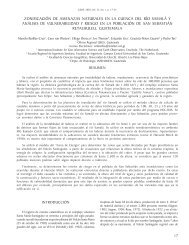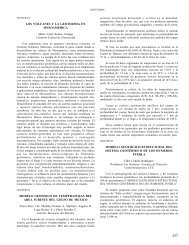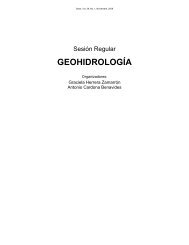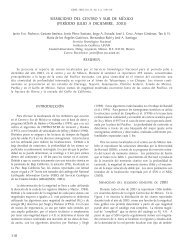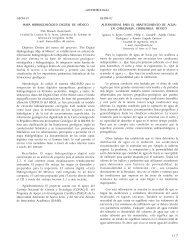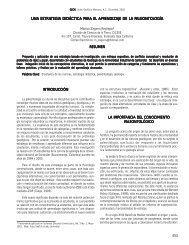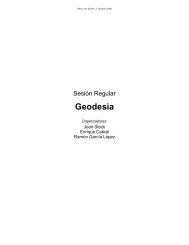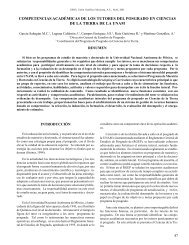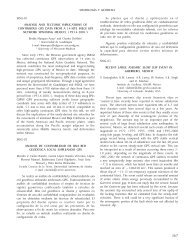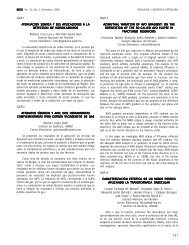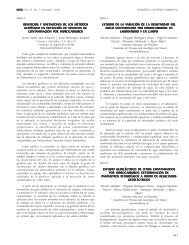Libro de Resúmenes - Unión Geofisica Mexicana AC
Libro de Resúmenes - Unión Geofisica Mexicana AC
Libro de Resúmenes - Unión Geofisica Mexicana AC
You also want an ePaper? Increase the reach of your titles
YUMPU automatically turns print PDFs into web optimized ePapers that Google loves.
GEOMAGNETISMO Y PALEOMAGNETISMO Geos, Vol. 30, No. 1, Noviembre, 2010<br />
GEOPAL-1<br />
ESTUDIO PALEOMAGNÉTICO DE FLUJOS DE LAVA FECHADOS<br />
POR AR-AR DEL CAMPO VOLCÁNICO MICHO<strong>AC</strong>ÁN GUANAJUATO<br />
Maciel Peña Rafael 1 , Gogichaishvili Avto 1 , Garduño Monroy Víctor H. 2 ,<br />
Guilbaud Marie-Noëlle 1 , Siebe Claus 1 , Morales Juan 1 y Aguilar Reyes Bertha 1<br />
1 Universidad Nacional Autónoma <strong>de</strong> México<br />
2 Universidad Michoacana <strong>de</strong> San Nicolás <strong>de</strong> Hidalgo<br />
rafaelmacielmx@yahoo.com.mx<br />
Este trabajo presenta nuevos resultados paleomagnéticos <strong>de</strong> 74 unida<strong>de</strong>s <strong>de</strong><br />
enfriamiento in<strong>de</strong>pendientes pertenecientes al Campo Volcánico Michoacán<br />
Guanajuato (CVMG) en el oeste <strong>de</strong> México. Se muestraron cerca <strong>de</strong> 750<br />
muestras paleomagneticas estándar <strong>de</strong> cuatro localida<strong>de</strong>s (Jorullo, Tancitaro,<br />
Valle <strong>de</strong> Santiago y Tacambaro). Todos los sitios estan fechados por el método<br />
radiométrico <strong>de</strong> Ar-Ar y las eda<strong>de</strong>s van <strong>de</strong>s<strong>de</strong> 5 Ma hasta la actualidad.<br />
La paleodirección característica fue aislada para 64 flujos <strong>de</strong> lava, <strong>de</strong> los cuales<br />
52 mostraron polaridad normal, 10 invertida y dos intermedia. La principal<br />
paleodirección obtenida es I=33.24°, D= 354.7°, #95=4.3º, lo cual correspon<strong>de</strong><br />
a una posición <strong>de</strong>l polo <strong>de</strong> Plat= 83.74º, Plong= 347.7º, y #95=4.3º. Estas<br />
direcciones son prácticamente indistinguibles <strong>de</strong> la esperada paleodirección <strong>de</strong>l<br />
Plio-Cuaternario, como la obtenida <strong>de</strong>l polo <strong>de</strong> referencia para el cratón norte<br />
americano.<br />
La variación paleosecular se estimo a través <strong>de</strong> estudiar la dispersión <strong>de</strong>l<br />
polo geomagnético virtual dando SB=14.2, SU=16.2 SL=12.7 (límite superior e<br />
inferior respectivamente), lo cual correspon<strong>de</strong> con el mo<strong>de</strong>lo G <strong>de</strong> McFad<strong>de</strong>n<br />
et al. (1988, 1991) y la nueva compilación <strong>de</strong> Johnson et al. (2008) para los<br />
últimos 5 Ma.<br />
Se encontraron sitios que no coinci<strong>de</strong>n con lo esperado en los crones <strong>de</strong> Gauss<br />
y Matuyama, que se pue<strong>de</strong>n atribuir a subcrones como el <strong>de</strong> Reunion, Halawa,<br />
Big lost, Lashamps entre otros.<br />
La combinación <strong>de</strong> otras lavas rediometricamente fechadas provenientes <strong>de</strong> la<br />
Faja Volcanica Trans-<strong>Mexicana</strong> ofrece 106 lecturas in<strong>de</strong>pendientes <strong>de</strong> campo<br />
magnetico terrestre obteniendo así el registro paleomagnetico mas completo<br />
hasta ahora conocido para los últimos 5Ma.<br />
Palabras clave: Variación paleosecular, Inversiones, TAFI, Plioceno,<br />
Pleistoceno, Oeste <strong>de</strong> México, campo Volcánico Michoacán Guanajuato<br />
(CVMG), campo promediado en tiempo (TAF), Dipolo Geocéntrico axial (GAD),<br />
Faja Volcánica Transmexicana (FVTM).<br />
GEOPAL-2<br />
PALEOINTENSIDADES DE LAVAS<br />
HOLOCENICAS DE LA ISLA DE MAUI, HAWAII<br />
Böhnel Harald 1 , Herrero Bervera Emilio 2 , Dekkers<br />
Mark 3 , Hagstrum Jonathan 4 y Champion Duane 4<br />
1 Centro <strong>de</strong> Geociencias, UNAM<br />
2 Hawaii Institute of Geophysics<br />
3 Utrecht University<br />
4 US Geological Survey<br />
hboehnel@geociencias.unam.mx<br />
En la isla <strong>de</strong> Maui en Hawaii se han emplazado al menos 70 flujos <strong>de</strong><br />
lava durante los últimos 50 ka. Estos se han estudiado por parte <strong>de</strong>l USGS<br />
para evaluar el riesgo volcánico y muchos han sido fechados por el método<br />
<strong>de</strong> carbono-14. Tambien muchos se han estudiado paleomagnéticamente<br />
para correlaciones entre flujos y para fechamiento magnético (Sherrod et al.,<br />
2006). Muestras <strong>de</strong> la colección <strong>de</strong>l USGS nos fueron proporcionadas para<br />
experimentos <strong>de</strong> propieda<strong>de</strong>s magnéticas y <strong>de</strong> paleointensida<strong>de</strong>s.<br />
Las propieda<strong>de</strong>s magnéticas estudiadas incluyen <strong>de</strong>terminaciones <strong>de</strong><br />
temperaturas Curie en una muestra por flujo, y curvas <strong>de</strong> la histéresis magnética<br />
<strong>de</strong> las mismas muestras. Una muestra por flujo se utilizó para <strong>de</strong>terminaciones<br />
<strong>de</strong> paleointensida<strong>de</strong>s con el método <strong>de</strong> Thellier-Coe, con el fin <strong>de</strong> evaluar si<br />
serian útiles para este tipo <strong>de</strong> experimentos. Solo una <strong>de</strong> 80 muestras cumplió<br />
con los criterios <strong>de</strong> aceptación, las <strong>de</strong>más 79 fueron rechazadas.<br />
Por esta razón se aplicó el método <strong>de</strong> multi-especimenes (Dekker & Böhnel,<br />
2006), en parte con el protocolo original, y en otra parte con un protocolo<br />
modificado. En este momento contamos con resultados <strong>de</strong> 15 flujos <strong>de</strong> lava <strong>de</strong><br />
los últimos ~16 ka BPcal.<br />
Dekkers, M. and Böhnel, H., 2006. Reliable absolute palaeointensities<br />
in<strong>de</strong>pen<strong>de</strong>nt of magnetic domain state. Earth Planet. Sci. Lett., 248, 507-516.<br />
Sherrod, D.R., Hagstrum, J.T., McGeehin, J.P., Champion, D.E. and Trus<strong>de</strong>ll,<br />
F.A., 2006. Distribution, 14C chronology, and paleomagnetism of latest<br />
Pleistocene and Holocene lava flows at Haleakala volcano, Island of Maui,<br />
Hawai‘i: A revision of lava flow hazard zones. J. Geophys. Res., 111, B05205,<br />
doi:10.1029/2005JB003876.<br />
GEOPAL-3<br />
RESULTADOS PRELIMINARES SOBRE LA VARI<strong>AC</strong>IÓN PALEOSECULAR<br />
DEL CAMPO VOLCÁNICO EL PIN<strong>AC</strong>ATE, SONORA, MÉXICO<br />
Rodríguez Trejo Alejandro 1 , Alva Valdivia Luis 1 , Vidal Solano<br />
Jesús 2 , Calmus Thierry 1 , Cañón Tapia Edgardo 3 y Montes Osvaldo 4<br />
1 Universidad Nacional Autónoma <strong>de</strong> México<br />
2 Universidad <strong>de</strong> Sonora<br />
3 Centro <strong>de</strong> Investigación Científica y <strong>de</strong> Educación Superior <strong>de</strong> Ensenada<br />
4 Instituto Politécnico Nacional<br />
alex_rguez@hotmail.com<br />
El Campo Volcánico El Pinacate (CVP) consta <strong>de</strong> <strong>de</strong>rrames antiguos que están<br />
cubiertos y ro<strong>de</strong>ados <strong>de</strong> <strong>de</strong>rrames y conos cineríticos más jóvenes. Estos<br />
conos son el tipo más común <strong>de</strong> edificio volcánico, y notablemente abundantes<br />
aquí; más <strong>de</strong> 400 <strong>de</strong> ellos se concentran en el área <strong>de</strong> <strong>de</strong>rrames <strong>de</strong> 1,500<br />
kilómetros cuadrados. Menos comunes, geológicamente hablando, son los<br />
gran<strong>de</strong>s cráteres o maars: cráteres formados por explosiones <strong>de</strong> vapor cuando<br />
lava líquida ascen<strong>de</strong>nte se encuentra con agua en el subsuelo. Existen ocho<br />
maars más un cono <strong>de</strong> toba (Cerro Colorado, el cual cuenta con su propio<br />
cráter) y un anillo <strong>de</strong> toba (Cráter Díaz). Se reportan resultados <strong>de</strong> un estudio<br />
paleomagnético don<strong>de</strong> se colectaron muestras <strong>de</strong> 19 sitios (235 núcleos) <strong>de</strong><br />
diferentes flujos <strong>de</strong> lava. Se reportan análisis <strong>de</strong> propieda<strong>de</strong>s magnéticas<br />
(curvas <strong>de</strong> susceptibilidad vs. temperatura, histéresis, análisis <strong>de</strong> FORC, IRM<br />
y dIRM, etc.), estudios <strong>de</strong> microscopia y resultados <strong>de</strong> los procesos <strong>de</strong> análisis<br />
<strong>de</strong> los espectros <strong>de</strong> <strong>de</strong>smagnetización por campos alternos y/o temperatura. No<br />
obstante el objetivo principal es calcular la variación paleosecular basado en<br />
estudios geocronológicos previos.<br />
GEOPAL-4<br />
AUSTRALASIAN VOLCANIC RECORDS OF THE EARTH’S<br />
MAGNETIC FIELD DURING POLARITY TRANSITIONS:<br />
PALEOMAGNETIC EVIDENCES FOR A POSSIBLE<br />
MANTLE INFLUENCE OVER THE GEODYNAMO?<br />
Camps Pierre 1 , Fanjat Gregory 2 , Hoffman Ken 3 , Perrin Mireille 2 y Poidras Thierry 2<br />
1 CNRS and University of Montpellier, France<br />
2 Géosciences Montpellier, CNRS and Université Montpellier 2, France<br />
3 California Polytechnic State University, San Luis Obispo, California, USA<br />
camps@gm.univ-montp2.fr<br />
Since three years, we are conducting a regional, temporally comprehensive<br />
paleomagnetic study focussed on lavas from Australasia in or<strong>de</strong>r to investigate<br />
the geomagnetic field behavior, especially during polarity reversals and events,<br />
since the Mesozoic. Most available transitional field data are associated with the<br />
last 2 Ma of geodynamo history with the number of existing records becoming<br />
increasingly sparse as one proceeds back through the tertiary and into the late<br />
Mesozoic. Yet, only through a temporally long view can we recognize whether<br />
any systematics are present and, if so, whether any spatial changes in the<br />
un<strong>de</strong>rlying dynamo process has occurred over geological time. Further, these<br />
unresolved questions are strongly tied to the controversy as to whether or not<br />
core mantle interactions impose an observable influence on the transitional<br />
field. We already studied two polarity reversals and one excursion in Australia<br />
(Quamby Fall reversal at Tweed volcano, Queensland, ~25.6 Ma (Hoffman et<br />
al., PEPI, 2008); Liverpool reversal at Liverpool range, NSW, ~35 Ma; Barrington<br />
Top excursion, NSW, ~50 Ma). More recently, we resampled two polarity<br />
reversals of late Miocene age (~ 9.0 Ma) recor<strong>de</strong>d successively in the Akaroa<br />
volcano, South Island New Zealand.<br />
The transitional VGPs do not appear to be randomly distributed, but rather<br />
show a preference to resi<strong>de</strong> either in and about Australasia or in the South<br />
Atlantic, even though they represent more than 40 Ma of geomagnetic behavior.<br />
More unexpected, intensity <strong>de</strong>terminations from the Liverpool lava flows yiel<strong>de</strong>d<br />
values stronger during the transitional period than during the stable period<br />
that prece<strong>de</strong>d the reversal. Old paleointensity <strong>de</strong>terminations by Sherwood<br />
and Shaw (1986) on Akaroa sequence seem to show the same trend. These<br />
observations are opposite to what is generally observed during a polarity<br />
reversal. An increase in intensity during the reversal would provi<strong>de</strong> an extreme<br />
example of increasing secular variation during the reversal. However, the<br />
experimental method used for <strong>de</strong>termining the paleointensities from Akaroa lava<br />
flows, method of Shaw, is questioned by the scientific community. A check of<br />
these data by the conventional Thellier method is in progress.<br />
52



![Libro de resúmenes [revisión final, 172 páginas] - UGM](https://img.yumpu.com/51565067/1/190x245/libro-de-resamenes-revisian-final-172-paginas-ugm.jpg?quality=85)
